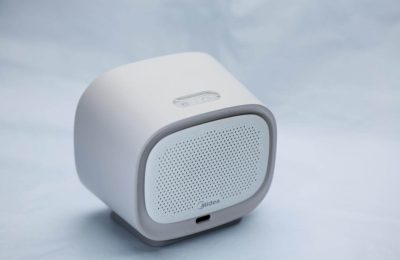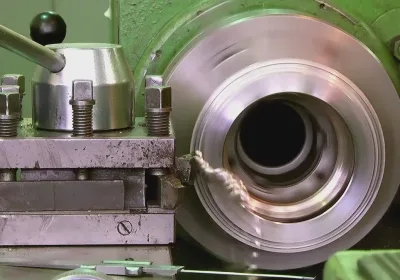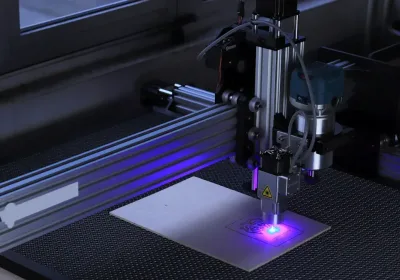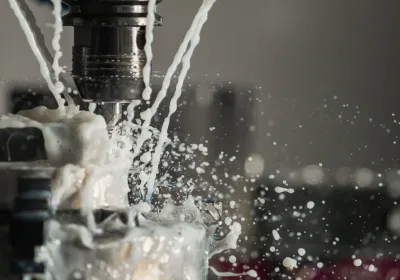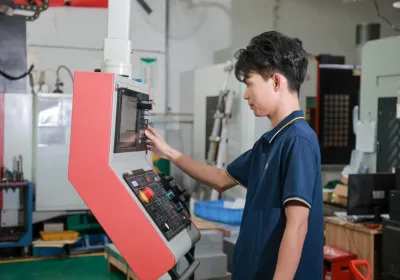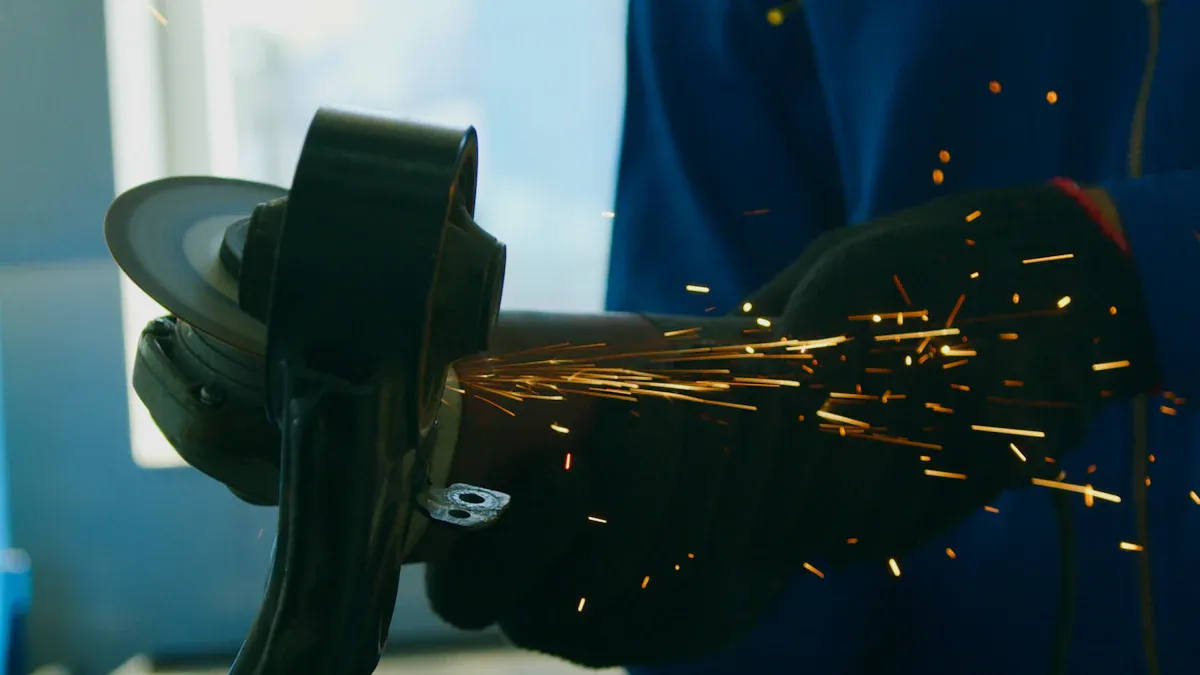
Choosing the right machine for grinding is very important for factories. The right machine for grinding makes work faster and saves energy by 7.62%. It also increases production by 4.42%. This helps industries like aerospace and cars that need smooth finishes. Modern machines with smart features like IoT and learning tools work even better. They help lower costs and keep work steady. Picking the best machine for grinding gives smoother surfaces, better accuracy, and more dependable results.
Key Takeaways
Picking the right grinding machine helps work faster and saves energy. It also improves production, which is important for exact finishes.
Grinding machines are flexible and precise. They are used in cars, planes, and medical tools.
Think about the material and how precise you need to be. This helps the machine work well and avoids wasting materials.
New grinders with smart features are more accurate. They make work easier and speed up production.
Plan your budget by checking all costs. Buying good machines can save money over time and give better results.
Overview of Grinding Machines
What is a Grinding Machine
A grinding machine is a tool that removes material to shape or smooth objects. It uses a spinning abrasive wheel to cut into the material. This process helps make parts the right size and gives them a smooth finish.
The machine works by using an electric motor to spin the grinding wheel at a set speed, which removes material.
Key parts of a grinding machine include the grinding wheel, a device to hold the workpiece, and a coolant system. These parts work together to make the process accurate and efficient. For example, the grinding wheel cuts the material, while the coolant keeps the machine from getting too hot.
Benefits of Grinding in Manufacturing
Grinding has many advantages for making things. It helps create very precise parts with smooth surfaces, which is important for industries like cars and airplanes. Grinding machines can make parts with exact measurements and consistent quality.
Improved Efficiency: Grinding makes production faster. For example, one company reduced its work time from 30 minutes to 11 minutes, saving over $80,000 each year.
Cost Savings: These machines help tools last longer and waste less material, cutting costs.
Enhanced Flexibility: Modern machines, like CNC grinders, can switch tasks quickly, making them useful for different jobs.
These benefits make grinding a key part of modern manufacturing.
Common Applications for Grinding Machines
Grinding machines are used in many industries to make high-quality parts. Here are some examples:
Industry | Applications |
|---|---|
Industrial Machinery | Making spindles, shafts, and rollers with smooth finishes and accuracy. |
Electrical and Electronics | Creating connectors, pins, and housings for precise devices. |
Automotive | Producing engine parts, transmission pieces, and bearings with exact engineering. |
Aerospace | Building important parts like engine components and landing gear with high precision. |
These examples show how grinding machines are useful in different fields.
Types of Grinding Machines
Surface Grinding Machines
Surface grinding machines are widely used in factories. They are great for making flat and smooth surfaces on materials. These machines use a spinning abrasive wheel to remove material carefully.
Surface grinders work best when a smooth finish is needed. For instance, industries like cars and airplanes use them to make engine parts and precise tools.
Tip: Clean the grinding wheel often to keep it working well.
Comparative Performance
Surface grinders are better at removing material and making smooth finishes than other machines. The table below shows their performance:
Tool Type | Material Removal Efficiency | Surface Roughness (Ra) |
|---|---|---|
Tool #1 | Low | |
Tool #2 | Doubled | Decreased to Ra = 0.36 µm |
These machines are important for making accurate and smooth products. They are a key part of factory work.
Cylindrical Grinding Machines
Cylindrical grinders are made to shape round objects. They can work with many materials like steel, titanium, and ceramics. These machines are perfect for jobs that need very exact measurements and smooth finishes.
Key Features
Can achieve very tiny size differences for precise work.
Makes smooth surfaces while wasting less material.
Cuts down on extra finishing steps, saving time.
Uses CNC systems to automate tasks, boosting speed and accuracy.
Helps tools last longer by reducing wear and tear.
Cylindrical grinders are great for making shafts, rollers, and other round parts. They are also good for single or small-batch projects because they switch tasks quickly.
Centerless Grinding Machines
Centerless grinders are special because they don’t need clamps to hold the material. Instead, the material is placed between a grinding wheel and a guiding wheel. This setup allows for nonstop grinding, making them very fast for big jobs.
Centerless grinders are often used to make small round parts like pins and bearings. Industries like cars and electronics rely on them for their speed and precision.
Note: Centerless grinders are best for jobs where parts need quick and accurate grinding without being clamped.
These machines are flexible and play an important role in modern manufacturing.
Internal Grinding Machines
Internal grinding machines work on the inside of round objects. They are used to make the inner surfaces smooth and the right size. These machines are great for parts like tubes, bearings, or bushings. Unlike surface grinders, they focus on the inside of a part, making them perfect for detailed designs.
Why Use Internal Grinding Machines?
Internal grinders have many benefits:
Precision: They make parts very accurate and meet exact sizes.
Versatility: They work with metals, ceramics, and other materials.
Productivity: They remove material quickly, saving time.
Ease of Use: Automation features make setup simple and fast.
Cost Savings: They use materials efficiently, reducing the need for extra machines.
Tip: Clean the grinding wheel often to keep it working well.
Internal grinders are important for industries like aerospace and cars that need detailed inside shapes.
Tool and Cutter Grinding Machines
Tool and cutter grinding machines sharpen tools like drills and cutters. They keep tools sharp and ready for high-quality work. These machines are essential for factories that need precise cutting tools.
Better Performance Features
New improvements make these machines work even better:
Improvement | What It Does |
|---|---|
Speeds up work by automating tasks. | |
Precision | Reduces vibrations for smoother finishes. |
Stability | Makes grinding wheels last longer and keeps machines steady. |
Tool and cutter grinders are needed in industries like tool-making and electronics.
Note: Take care of these machines to keep them working well for a long time.
Special-Purpose Grinding Machines
Special-purpose grinding machines are made for unique jobs. They handle tasks that regular grinders can't do easily. These machines are used in industries like medical devices and aerospace.
What Makes Them Special
Special-purpose grinders have advanced features:
Feature/Benefit | What It Does |
|---|---|
Makes detailed shapes for medical tools. | |
Direct drive technology | Moves smoothly and reduces wear. |
Specialized software | Helps program different shapes easily. |
Simulation capabilities | Tests designs before production to save time. |
Milling capability | Combines grinding and milling for faster work. |
These machines are great for making complex items like medical implants or airplane parts.
Tip: Buying a special-purpose grinder can make your work faster and more efficient.
Selecting the Right Grinding Machine
Material Type and Compatibility
When picking a grinding machine, think about the material you’ll use. Different materials need special grinding methods for the best results. For example, strong metals like steel and titanium need tough grinders. On the other hand, ceramics and composites need machines that handle them gently. The grinding wheel is also important. Its abrasive material must match the workpiece to avoid damage and work efficiently.
Tip: Use surface grinders for flat surfaces and detailed designs. They are common in tool-making industries.
Check if the grinder works with the sizes and types of materials you use often. It should fit into your current workflow and software tools to avoid delays. For instance, if you make precise parts, a grinder with advanced CNC features can improve accuracy and surface quality.
Precision and Tolerance Requirements
Precision is very important in grinding. Think about how exact your parts need to be. Grinding machines can achieve very tight tolerances, like 0.0002 inches, and smooth finishes, as fine as 2 microinches Ra. This makes them essential for industries like aerospace and medical devices, where small errors can cause big problems.
Modern grinders use advanced features like linear motors to stay stable and reduce vibrations. This helps them deliver consistent results. Tools like in-process gaging systems let you check and adjust tolerances while grinding. But remember, larger parts can be harder to grind precisely and may need special machines.
Note: Higher precision often costs more. Balance your needs with your budget.
Production Volume and Speed
How much and how fast you need to produce affects your grinder choice. High-speed grinders are great for making many parts quickly. For instance, one factory made 19,000 pieces in 8 hours with an efficiency rate of 86.31%. By lowering rejected parts, they added 5,200 more pieces daily, showing how speed boosts production.
Grinders with CNC controls and automation save time by needing less operator input. These features improve quality and shorten production cycles. Tracking metrics like OEE helps find problems and improve output, so you can meet customer needs better.
Callout: To produce efficiently, aim for fast speeds with no downtime or defects. Pick a grinder that matches your production goals for the best results.
Workspace and Machine Size
When picking a grinding machine, think about your workspace size. A machine that fits well helps work go smoothly. Compact machines, like the WPG 7, are great for small spaces. They pack important parts into a small design without losing performance.
Machines should also be flexible. Automated systems are good for big jobs. Manual loading works better for smaller tasks. This makes grinding efficient for all kinds of work. Easy-to-use CNC controls make switching tasks faster and more accurate.
Here’s a simple look at workspace tips:
Consideration | Description |
|---|---|
Size Matters | Compact machines like the WPG 7 fit small spaces and work well. |
Flexibility in Loading | Automation helps big jobs; manual loading is good for quick changes. |
Ease of Operation | CNC controls make programming easy and save time. |
To make the most of your space, plan how the machine fits into your workflow. A smart layout reduces delays and boosts productivity. For example, organizing steps in order helps work move faster. Flexible layouts also prepare your factory for future changes.
Design Tip | Description |
|---|---|
Compartmentalize Processes | Arrange steps to reduce delays and improve work speed. |
Prioritize Flexibility | Make layouts adaptable for growth and new tasks. |
Tip: Measure your workspace before buying a machine. Make sure it fits well and works smoothly in your factory.
Budget and Cost Considerations
Your budget is very important when choosing a grinding machine. Think about upfront costs and long-term expenses like repairs and energy use. A Total Cost of Ownership (TCO) analysis can help you compare machines and pick the best one.
Spending more on a high-quality machine often pays off. Studies show businesses save money with advanced grinders. These machines are precise, waste less material, and work faster. For example, CNC grinders give great accuracy and save money by using less material.
Here’s a breakdown of cost factors:
Evidence Type | Description |
|---|---|
Case Studies | Examples of businesses saving money with advanced machines. |
TCO Analysis | Looks at all costs, like setup, repairs, and energy use. |
ROI Calculation | Shows how good machines give better returns over time. |
Balancing cost and performance is key. Cheaper machines might not have the features you need. More expensive machines often give better results, making them worth the price.
Callout: Think about long-term savings when buying a machine. Spending more now can save money and improve work later.
Advanced Features in Grinding Machines
Automation and CNC Capabilities
Automation and CNC grinding machines have changed how factories work. These machines need less human effort, so workers can do other jobs. For example, robots like the FANUC R2000iC/210F help by moving materials automatically. CNC controls also make work more accurate, giving smooth and precise finishes.
Industries like airplanes and cars benefit a lot from these features. In airplane part factories, robots increased daily production by 30% and improved surface quality. Car part makers using smart systems reduced grinding wheel wear by 20%, saving money and making tools last longer.
Tip: Pick CNC grinding machines with automation to save time and reduce waste.
Energy Efficiency and Sustainability
Energy-saving grinding machines help lower energy use in factories. New designs use less power, cutting costs and saving money. For example, one factory lowered CO2 emissions to 155,525 tons by managing energy better. This shows how saving energy helps both the environment and businesses.
Grinding uses a lot of energy, especially in mining. Using energy-saving machines reduces harm to the planet while keeping production steady. These machines also give smooth finishes without wasting energy.
Callout: Energy-efficient grinding machines save money and support eco-friendly manufacturing.
Smart Sensors and IoT Integration
Smart sensors and IoT have improved grinding machine performance. These tools collect data and help adjust settings to work better. For instance, some machines with IoT can change settings automatically to avoid delays and improve accuracy.
Connected machines are key in modern factories. They let you check and control them remotely, keeping work steady and precise. Data from these machines helps predict problems, avoiding costly repairs and making machines last longer.
Note: IoT-enabled grinding machines give great accuracy and flexibility, perfect for today’s factories.
Noise and Vibration Reduction
Grinding machines can be loud and shaky, causing problems at work. Newer designs aim to fix this by making them quieter and steadier. Less vibration means smoother finishes and longer-lasting tools.
How Modern Machines Reduce Vibrations
Manufacturers use smart designs to cut down vibrations. These updates make machines easier to use and more effective. For example:
Vibration acceleration in improved models dropped to 7.00 m/s² from 15.60 m/s².
Vibrations in the Y-direction of the frame went from 11.90 m/s² to 8.12 m/s².
Vehicle skin vibration under use fell to 7.34 m/s², just 30% of the old model's level.
These upgrades boost performance and make workspaces safer and more comfortable.
Benefits of Noise Reduction
Quieter machines help you focus and feel less tired. Noise-dampening designs use special materials to absorb sound. This is great for places like medical or electronics factories where focus is key.
Tip: Choose machines with frames that reduce shaking and enclosures that lower noise. These features improve your work environment.
Picking a machine with noise and vibration control improves your work quality. It also protects your hearing and boosts productivity. These features are worth the investment for better results and comfort.
Common Uses for Grinding Machines in Different Industries
Car Manufacturing
Car factories depend on grinding machines to make precise parts. These machines create items like camshafts, gears, and crankshafts. They ensure parts are smooth and fit perfectly. Both gas-powered and electric cars need these exact parts. Grinding improves part surfaces by 53% and cuts finishing time by 49%. This helps carmakers meet the rising demand for vehicles, which reached 85.4 million in 2022, up 5.7% from 2021.
Robotic grinders make production lines faster and more flexible. They boost flexibility by 45% and speed by 42%. These upgrades save materials and make grinding machines essential for modern car-making.
Airplane and Defense Manufacturing
In airplanes and defense, grinding machines make very accurate parts. These include turbine blades and other key components. These parts must work well in tough conditions. Grinding ensures they meet strict size and smoothness needs. It also balances heat, material removal, and tool wear.
Automation and AI have made grinding even better. Special grinders handle tough materials like titanium and nickel alloys. These materials are strong and resist heat, perfect for airplanes. Advanced grinding keeps airplane parts safe and reliable.
Medical Equipment Making
Grinding machines are crucial for making medical tools and implants. These items need smooth surfaces to be safe for patients. For example, grinders turn rough surfaces into smooth ones, stopping rust and making devices last longer.
Materials like titanium and ceramics are common in medical tools. Grinding machines can shape these materials with extreme accuracy. They make implants like joint replacements fit perfectly. Smooth finishes also reduce wear and lower repair costs. This shows how important grinders are in healthcare manufacturing.
Tool and Die Making
Tool and die making depends on grinding machines for accurate tools. These tools shape materials in industries like cars, planes, and factories. Grinding machines make sure tools are smooth and sharp for quality work.
Modern machines, like CNC grinders, have changed tool-making. They are very precise and fast, making complex designs easy. For example, Almar Tools Inc. uses advanced WALTER CNC grinders. These machines help them finish custom tools in days, not weeks. Skilled workers with years of experience ensure every tool is top quality.
Grinding machines also speed up work and reduce waste. They save material and cut costs while keeping high standards. Whether for factory tools or special jobs, grinders are key for strong and precise tools.
Electronics and Semiconductor Industry
Grinding machines are crucial for making precise parts in electronics. These industries need smooth and exact parts for devices like phones and chips.
Grinders make connectors, housings, and wafers for semiconductors. They create flat, smooth surfaces on materials like silicon and ceramics. This ensures parts fit well and work perfectly in high-tech gadgets.
Advanced grinders with automation and IoT improve efficiency. They let you adjust processes in real time, reducing mistakes. Adding these machines to your production line boosts speed and keeps quality steady.
Grinding machines are vital for electronics and semiconductors. Their accuracy and flexibility make them essential for modern manufacturing.
Picking the right grinding machine is very important for factories. Knowing the types and uses of these machines helps you choose the best one. Important things to check include speed, strength, cooling systems, and upkeep. Think about what your factory needs and ask experts for advice. A good grinding machine makes work faster, saves money, and gives steady, high-quality results.
FAQ
What matters most when picking a grinding machine?
Think about the material type and if the machine works with it. Different materials need special grinding methods and wheels. Choosing the right machine avoids damage and makes work efficient.
Tip: Check the machine's details to ensure it fits your material.
How do CNC grinding machines help factories?
CNC grinders do tasks automatically, so workers do less. They give accurate results and make production faster. You can set them up for different jobs, making them useful for many tasks.
Note: CNC machines save time and are great for big projects.
Are energy-saving grinding machines a good choice?
Yes, they use less power and save money over time. These machines also help the environment by lowering energy use.
Callout: Energy-saving machines cut costs and support green manufacturing.
How can I keep a grinding machine working well?
Clean it often and check for problems. Replace old grinding wheels and oil moving parts. Follow the maker’s care guide to avoid issues.
Tip: Good care keeps the machine working longer and better.
Can grinding machines make tricky shapes?
Yes, advanced grinders with five-axis systems can make detailed designs. They are perfect for industries needing exact shapes, like airplanes and medical tools.
Callout: Pick a machine with special features for hard-to-make shapes.
 LKprototype
LKprototype

